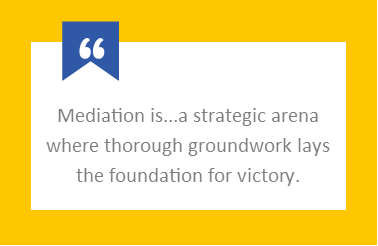
Published in Headnotes, Dallas Bar Association, by Alexandra Wahl, February 2024
Like a college homecoming football game, many attorneys underestimate the significance of mediation, assuming they can approach it casually due to its informal nature. However, preparing for mediation can provide a strategic advantage, including to start positioning the mediator in your favor early on, getting ahead in the game, and ensuring the most favorable settlement for your clients. The following six preparatory steps are key:
- 1. Craft a Comprehensive Mediation Statement. Even if the mediator does not require or request a mediation statement, sending one well in advance confers distinct advantages. By proactively providing a comprehensive playbook, you demonstrate a commitment to transparency and offer a roadmap to navigate the complexities of your case. The process of preparing a mediation statement also forces you to assess the nuances of your case before advising your client on settlement strategies. Ensure that thoughtfully highlighted and annotated key documents are attached for easy reference. This expedites the mediator’s understanding and ensures your perspective is presented with clarity and conviction. While the work to prepare the mediation statemen may seem to be an additional burden in an already demanding practice, the investment pays dividends in the form of a mediator who is better equipped to guide the parties toward a mutually agreeable resolution.
- 2. Prepare a Thoughtful First Offer. While revealing your position early in the negotiation process may seem counterintuitive, research consistently demonstrates that the party making the offer tends to be more satisfied with the final settlement. This phenomenon, known as “anchoring,” helps define the negotiation range. To maximize success, substantiate your offer with objective and legitimate considerations, preempting potential shell shock from the other side and setting the tone for the negotiation dance. By providing a well-reasoned initial offer, you anchor the range and position yourself as a proactive and reasonable player.
- 3. Navigate Non-Negotiables and Anticipate and Address Emotional Dynamics. Recognizing and navigating non-negotiables is a nuanced art. Guard against “reactive devaluation” – the inclination to dismiss a fair proposal solely because it originated from an adversary. Recognizing the psychological dynamics of mediation, engage your client constructively during breaks to identify true non-negotiables and explore creative solutions. Breaks provide valuable “timeouts” for reflection and recalibration, allowing you to ask hard questions and tailor your strategy in real time. Emotions can significantly influence the process. Sometimes, a simple apology or an opportunity for your client to voice grievances may significantly impact the resolution. It is not merely about the facts and figures; it is about understanding the parties’ underlying interests and addressing their emotional needs to forge a lasting resolution.
- 4. Develop a Basic Terms Sheet. The devil, they say, is in the details. Learn from past fumbles of agreements unraveling post-mediation due to nuanced legalese. Utilize downtime to compile a basic term sheet that both parties can sign before leaving the mediation. The term sheet will serve as a preliminary agreement, ensuring clarity and minimizing potential misunderstandings that could jeopardize the final settlement. By taking this additional step, you not only enhance the enforceability of the settlement but also contribute to the longevity of the agreed-upon terms.
- 5. Build a Rapport with Opposing Counsel. The relationship between opposing counsel often oscillates between adversarial and cooperative. Sometimes easier said than done, establishing a professional rapport can create a more collaborative atmosphere during mediation. This cooperation may facilitate smoother negotiations and increase the likelihood of finding mutually agreeable solutions through candor and transparency. It is an acknowledgment that, while each attorney is an advocate for their client, teamwork can lead to more efficient and effective dispute resolution.
- 6. Understand the Mediator’s Style and Approach. Football coaches tailor their game plans to the strengths and weaknesses of their opponents. Attorneys should also understand and plan their mediation strategies based on a mediator’s style and approach. The final piece of the preparatory puzzle involves understanding the mediator as a critical player in the negotiation dynamics. Ask around and familiarize yourself with the mediator’s background, style, and approach – are they facilitative, evaluative, or transformative? For example, if the mediator leans toward an evaluative style, it may be important to provide the mediator with concrete legal arguments and precedent may be more effective. On the other hand, a facilitative mediator may appreciate a collaborative approach focused on identifying shared interests and generating creative solutions. This insight can help you tailor our plays to align with the mediator’s preferences and get you into the red zone.
In conclusion, successful mediation involves meticulous preparation and strategic foresight before you even enter the stadium. By embracing the proactive measures outlined above, you can not only navigate the mediation process with finesse but also secure a more advantageous outcome for your clients. Mediation is not merely an informal encounter but a strategic arena where thorough groundwork lays the foundation for victory.
View PDF




